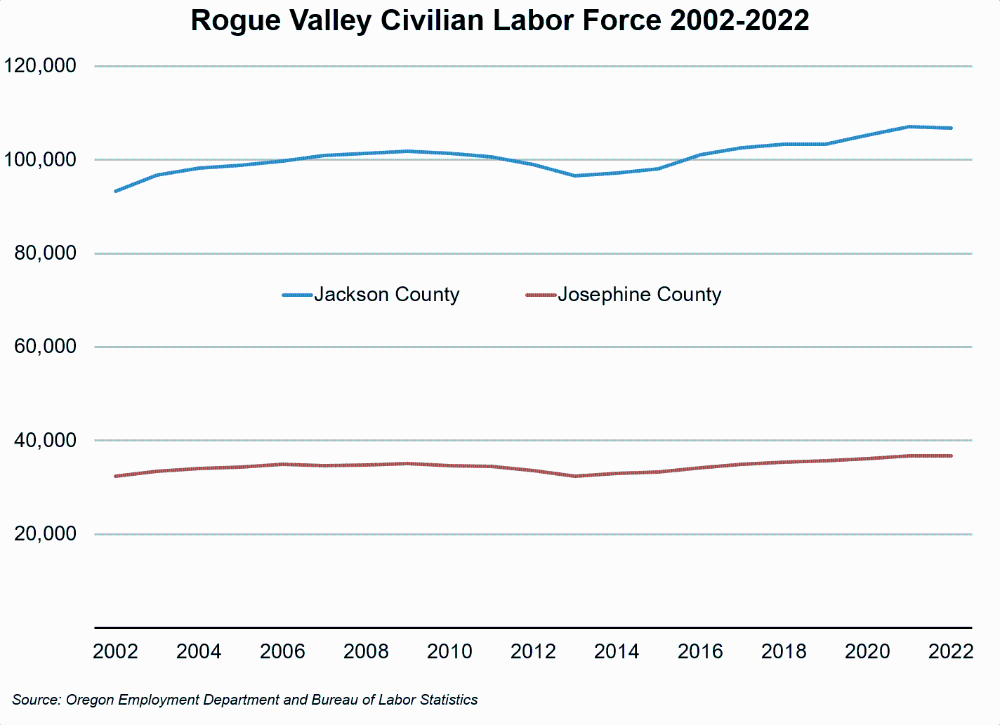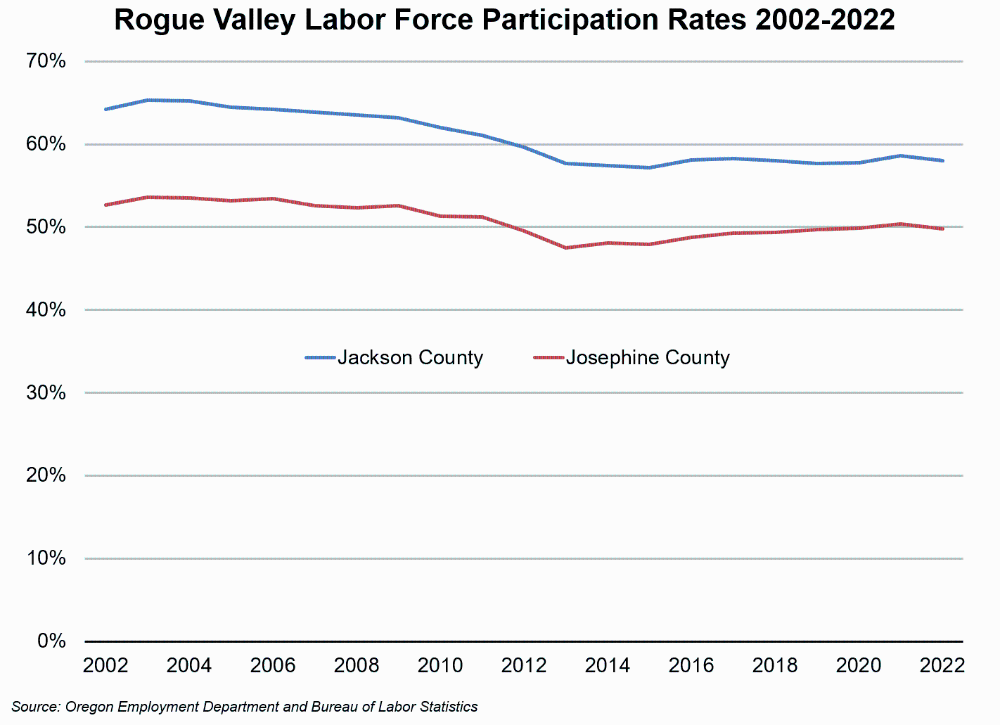Rogue Valley Labor Force Trends: Past and Future
September 11, 2023One concept that economics students may have studied is the concept of the production possibilities frontier, or production possibilities curve. It is a graphical representation of the boundary showing all the possible options of output for two goods that can be produced using all the factors of production. Those factors include land, capital, entrepreneurship, and also labor. In other words, its model that shows a naturally occurring speed limit on an economy based on those available resources. A goal of microeconomics is to utilize resources in the most efficient way to operate along, rather than inside that production possibilities curve. Now that you are glad you didn’t have to take microeconomics in your college major, let’s look more closely at one of those local factors in total economic output – labor, or more specifically trends in the Rogue Valley civilian labor force.
The civilian labor force is comprised of all persons 16 and older, excluding the institutional population (e.g., penal and mental facilities or homes for the aged) and those on active duty in the U.S. Armed Forces. For more detail and sources regarding who is in Oregon’s labor force see this recent article.

Looking back over the past 20 years, estimates from the Bureau of Labor Statistics Local Area Unemployment Statistics program show Jackson County’s labor force increased by 13,504 or a gain of 14.5% and climbed from 93,337 in 2002 to 106,841 in 2022. Comparing that with the most common working age cohort, the 18 to 64 year old population, data from Portland State University Population Research Center showed this group increasing by nearly the same, up by 14.0% or gaining 15,819 new Jackson County residents in this age group over that time.
Similarly in Josephine County, the civilian labor force grew by 13.7% or up by 4,433 and increasing from 32,372 to 36,805. The number of residents will exceed the civilian labor force because there are many, even in the 18 to 64 year old age bracket, that are not in the civilian labor force. In 2022, close to 2.18 million Oregonians were in the civilian labor force. Those not in the labor force are without employment and not engaged in an active job search. Around 1.3 million Oregonians were not in the labor force in 2022.

Another statistic that has been garnering attention recently is the labor force participation rate. That is defined as the percentage of the 16 and older civilian non-institutionalized population that is in the labor force: either working or seeking work in the past month. Jackson County’s labor force participation rate (LFPR) declined from 64.2% in 2002 to 58.0% in 2022. Josephine County’s LFPR slipped from 52.7% to 49.8% over that time. This few percentage point decline in the Rogue Valley’s LFPR is largely due to changing demographics and our aging population, as the LFPR includes essentially everyone 16 and older, and the fastest growing segments of our population have been those ages 65 and older. In Jackson County this older age group’s population rose by 75.9%, up by 22,301 from 2002 to 2022. This compares with an increase of 15,819 new residents age 18 to 64. Josephine County’s 65 and older population total rose by 50.4%, or an increase of 7,815. This compares with an increase of 4,777 new residents in the more typical working age cohort of those ages 18 to 64. An increasing share of older age population will put downward pressure on the overall LFPR, unless the LFPR among those older age groups rises substantially, which has not been the case during the recent COVID pandemic recession and recovery.
After looking at the past trends, what does the future hold and how might these trends affect the upcoming potential supply of labor – a factor in total economic output? A recent analysis published in an August 2023 Federal Reserve Bank of San Francisco Economic Letter calculated about a 1 percentage point drop in U.S. labor force participation rates in the next decade. They note, “Our analysis suggests that over two-thirds of the 1 percentage point drop in overall LFP from 2019 to 2022 can be attributed to a decline in trend LFP, with cyclical factors explaining the rest. Most of the drop in trend LFP is due to changes in the composition of the population, especially aging of the population. Looking ahead, we estimate that aggregate trend LFP will decline approximately 1 additional percentage point over the next decade, driven primarily by population aging.” If we use their estimates for labor force participation rate decline, and apply that to our county-level labor force participation rates and the most recent population by age group forecast for our local area from Portland State University’s Population Research Center, we can get a rough estimate of the expected labor force numbers in the Rogue Valley in the future.
Starting with the Jackson County 2022 population by age estimates shows 191,164 residents age 15+. If we apply the Jackson County labor force participation rate of 58.0% in 2022 to the age 15+ population, we get 110,875. The published civilian labor force figure that year was 106,841 (or 96.4% of the 15+ population). Applying the “Economic Letter” author’s expected decline in the labor force participation rate in the upcoming decade to our population by age forecasts up through 2030, we can expect an estimated labor force of 117,465 in 2030. This represents a gain of 9.9% from 2022 to 2030. Using the same methodology, Josephine County’s civilian labor force would be expected to grow from 36,805 in 2022 to 38,594 in 2030, an increase of 4.9% by 2030. Consider these estimates from the author, rather than official Oregon Employment Department projections.
Despite our aging population and a number of recessions over the past two decades, our labor force has continued to grow. If current population and demographic forecasts come to fruition, there should be a reasonable supply of labor for the Rogue Valley’s economy to continue to grow and expand.